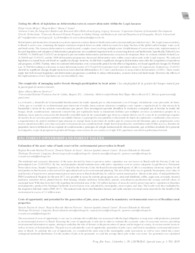Estimation of the asset value of lands reserved for environmental preservation in Brazil.
Estimation of the asset value of lands reserved for environmental preservation in Brazil.
Author(s): FERREIRA, R. R. M.; SOUZA, D. T. de; CASTRO, G. S. A.; MIRANDA, E. E. de
Summary: The territorial and economic dimension of the areas devoted by farms to preserve native vegetation was not known in Brazil until the Forestry Code was promulgated (Law 12,651/2012). By law, rural properties should maintain areas with native vegetation cover in various categories (Legal Reserve, Permanent Preservation Areas, Surplus Vegetation, etc.). Created by the Forestry Code, the Rural Environmental Registry (CAR) is a mandatory electronic registry for all rural producers that became a relevant tool for agricultural and socio-environmental planning. The aim of this study was to quantify the property asset value of each hectare of legal reserve and permanent preservation areas in Brazil should they be sold for current market prices. Based on the price of land published by FNP Consultoria & Negócio for the year 2017, it is possible to assess by activity group (grain, rice, semi-arid shrubland, coffee, sugar cane, savannah, Amazon rainforest, transition forest, planted forests, fruit farming, Atlantic rainforest, horticulture, pasture, miscellaneous production) the average and full values of municipal land. With data from the CAR regarding the territorial area of the 218 million hectares of areas devoted to preserving native vegetation in Brazilian rural properties, produced by Embrapa Territorial, reserved areas were calculated by municipality, micro-region, and state. The results were then multiplied by the respective full land values (FNP, 2017). The national total shows that Brazilian farmers and cattle ranchers own land assets reserved for the benefit of the environment in excess of 3.1 trillion reais.
Publication year: 2019
Types of publication: Abstract in annals or event proceedings
Unit: Embrapa Territorial
Keywords: Preserve native vegetation
Observation
Some of Embrapa's publications are published as ePub files. To read them, use or download one of the following free software options to your computer or mobile device. Android: Google Play Books; IOS: iBooks; Windows and Linux: Calibre.
Access other publications
Access the Agricultural Research Database (BDPA) to consult Embrapa's full library collection and records.
Visit Embrapa Bookstore to purchase books and other publications sold by Embrapa.

